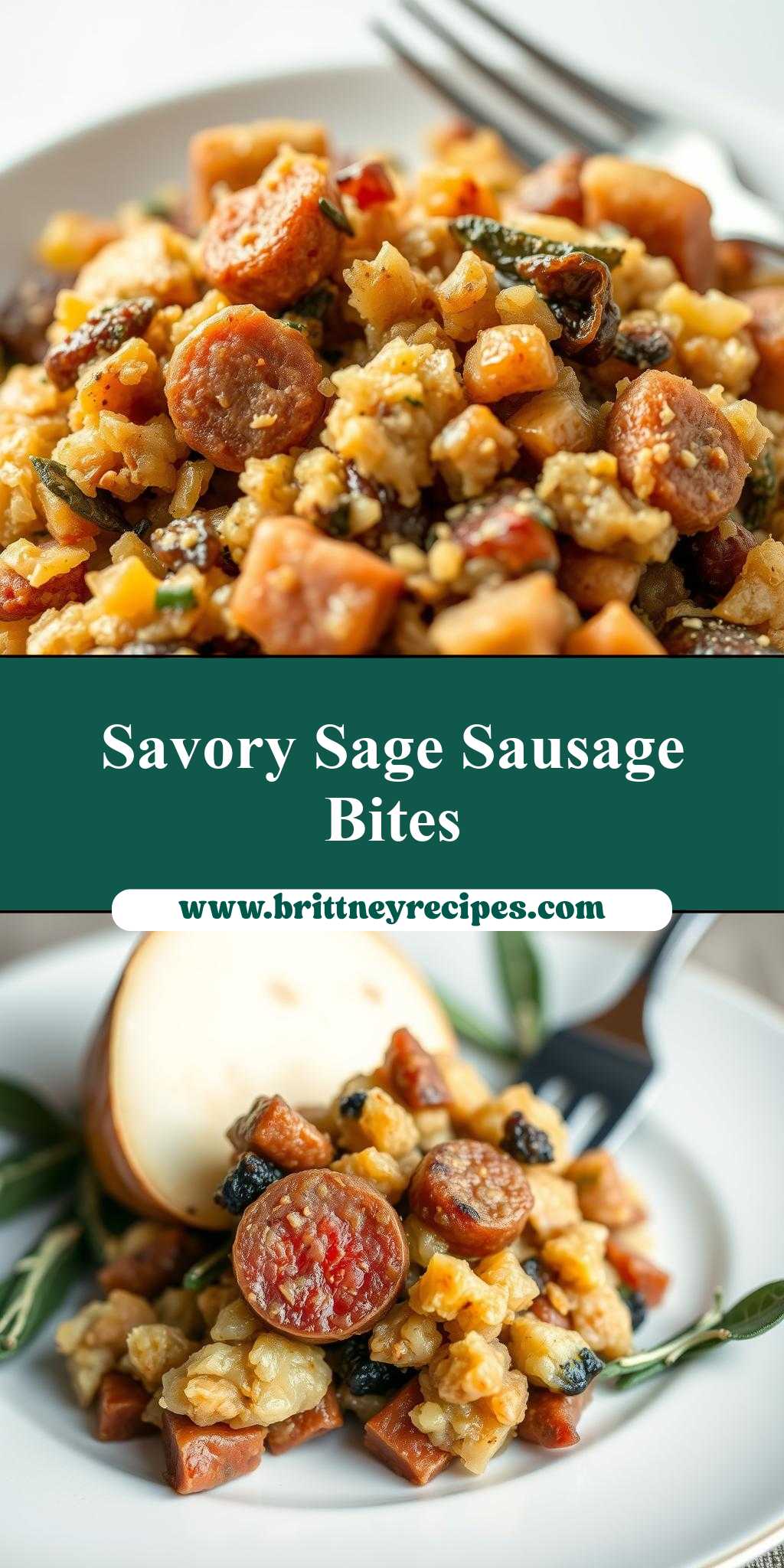What makes the perfect Thanksgiving side dish? It’s all about the flavors in this sage and sausage stuffing, made easy with just a few quick steps and homemade bread. With savory sausage and fragrant sage, this family favorite is sure to please. Save this idea for your next weeknight dinner or holiday meal.
Sage and Sausage Stuffing
Introduction
This Sage and Sausage Stuffing recipe is a masterclass in balance and flavor, combining the savory taste of sausage with the earthy undertones of sage, all wrapped up in a deliciously moist bread-based stuffing. What makes this dish truly special is its accessibility and ease of preparation. Using everyday ingredients and simple cooking techniques, you can create a truly impressive side dish that’s perfect for any occasion, from casual family dinners to special holiday gatherings. The creativity of this recipe lies in its ability to blend traditional flavors with a modern twist, making it a great addition to any meal.
Why This Works
- Flavor balance and ingredient accessibility: The combination of sage, sausage, and bread creates a harmonious balance of flavors that is both comforting and exciting. The ingredients are easily found in most supermarkets, making this dish accessible to anyone.
- Ease of preparation: Despite its impressive outcome, this recipe requires minimal effort and time, making it perfect for busy cooks who want to deliver a high-quality meal without spending hours in the kitchen.
- Impressive results with minimal effort: The end result is a dish that looks and tastes like it was prepared by a professional chef, but in reality, it can be made by anyone with basic cooking skills.
Key Ingredients
The main ingredients in this Sage and Sausage Stuffing include sausage (you can use any variety, but sage-infused sausage adds an extra layer of flavor), fresh sage leaves, bread (white or whole wheat, depending on your preference), onions, celery, garlic, chicken broth, and butter. For practical substitutions, you can use dried sage if fresh is not available, and you can also experiment with different types of bread or sausage to find your favorite combination.
Instructions
- Step 1: Begin by prepping your ingredients. Chop the onions, celery, and fresh sage leaves. Measure out the bread, sausage, chicken broth, and butter. This step is crucial as it sets the stage for the rest of the recipe, ensuring that everything is ready to go when you need it.
- Step 2: Cook the sausage in a pan until it’s browned, breaking it up into small pieces as it cooks. Remove the cooked sausage from the pan and set it aside. In the same pan, add the chopped onions, celery, and garlic and sauté until they’re tender. This step adds a depth of flavor to the dish and helps to bring all the ingredients together.
- Step 3: In a large mixing bowl, combine the cooked sausage, sautéed onion and celery mixture, chopped sage, bread, and chicken broth. Mix well until all the ingredients are fully incorporated and the bread is moist but not soggy. This is where the magic happens, and your stuffing starts to come together.
- Step 4: Transfer the stuffing mixture to a baking dish and dot the top with butter. Bake in a preheated oven until the top is golden brown and the stuffing is heated through. This final step brings everything together, adding a crispy, golden top to your sage and sausage stuffing.
Handy Tips
- One of the most helpful tips for this recipe is to not overmix the stuffing. This can make it dense and heavy. Instead, mix the ingredients just until they come together, and then stop. Also, using high-quality ingredients, like fresh sage and good sausage, can make a big difference in the flavor of the final dish.
Heat Control
If you’re baking the stuffing in the oven, the ideal temperature is 350°F (175°C). The timing will depend on whether you’re cooking the stuffing inside a bird or in a separate dish. As a general rule, if you’re cooking it in a dish, it should take about 25-30 minutes to heat through and brown on top. If you’re stuffing a bird, the cooking time will depend on the size of the bird and the temperature of your oven. Always use a meat thermometer to ensure the bird is cooked to a safe internal temperature.
Crunch Factor
The desired texture for this Sage and Sausage Stuffing is moist but not soggy, with a nicely browned and crispy top. To achieve this, make sure not to overmix the bread and broth, as this can lead to a dense stuffing. Also, baking the stuffing in a dish allows the top to crisp up nicely, adding a satisfying crunch to each bite.
Pro Kitchen Tricks
- One expert tip is to prepare the stuffing ahead of time up to the point where you would bake it, then refrigerate or freeze it until you’re ready to cook. This can save time on busy days and ensure that your stuffing is ready when you need it. Another trick is to use a variety of breads for added texture and flavor. Experimenting with different types of sausage or adding other ingredients like apples or nuts can also elevate the dish.
Storage Tips
- For leftover stuffing, cool it to room temperature, then refrigerate or freeze it. Refrigerated stuffing will keep for a few days, while frozen stuffing can be stored for several months. When reheating, make sure the stuffing is heated through to an internal temperature of 165°F (74°C) to ensure food safety. The best containers for storing stuffing are airtight, moisture-proof containers to keep it fresh.
Gift Packaging Ideas
While Sage and Sausage Stuffing might not be the first thing that comes to mind when thinking of gifts, it can actually make a wonderful and thoughtful present, especially during the holidays. Consider packaging it in decorative baking dishes or jars, wrapped in a ribbon or twine, and accompanied by a recipe card or a few fresh sage leaves. This can be a unique and delicious way to share your cooking with friends and family.
Flavor Variations
- Different spices: Try adding some dried herbs like thyme or rosemary to give the stuffing a unique twist. You can also experiment with spicy sausages for an added kick.
- Creative toppings: Adding some toasted nuts or dried cranberries on top of the stuffing before baking can add a nice texture and flavor contrast.
- Ingredient swaps: For a gluten-free version, use gluten-free bread. You can also substitute the sausage with bacon or ham for a different flavor profile.
Troubleshooting
- Texture problems: If your stuffing turns out too dry, it might be because the bread was too old or you didn’t use enough broth. Conversely, if it’s too soggy, you might have used too much broth or not baked it long enough.
- Ingredient replacements: If you can’t find sage-infused sausage, you can use regular sausage and add some dried or fresh sage to the mixture. Always taste as you go and adjust the seasoning accordingly.
- Over/undercooking signs: The stuffing is done when it’s heated through and the top is golden brown. If you’re unsure, check the internal temperature, which should be at least 165°F (74°C).
FAQs
- Can I freeze it? Yes, you can freeze the stuffing before or after baking. It’s best to freeze it before baking, as this helps preserve the texture of the bread.
- Is it gluten-free? Not as written, but you can make it gluten-free by using gluten-free bread and being mindful of the ingredients in the sausage and broth.
- Can I double the recipe? Yes, you can easily double or even triple this recipe if you’re serving a large crowd. Just keep an eye on the baking time, as larger quantities may take longer to cook through.
Conclusion
In conclusion, this Sage and Sausage Stuffing recipe is a versatile and delicious addition to any meal. With its balance of flavors, ease of preparation, and impressive results, it’s a dish that’s sure to become a favorite. Whether you’re a seasoned cook or just starting out, this recipe is approachable and adaptable, allowing you to make it your own with your favorite ingredients and twists. So, don’t be afraid to experiment and share your creations with friends and family. Happy cooking!

